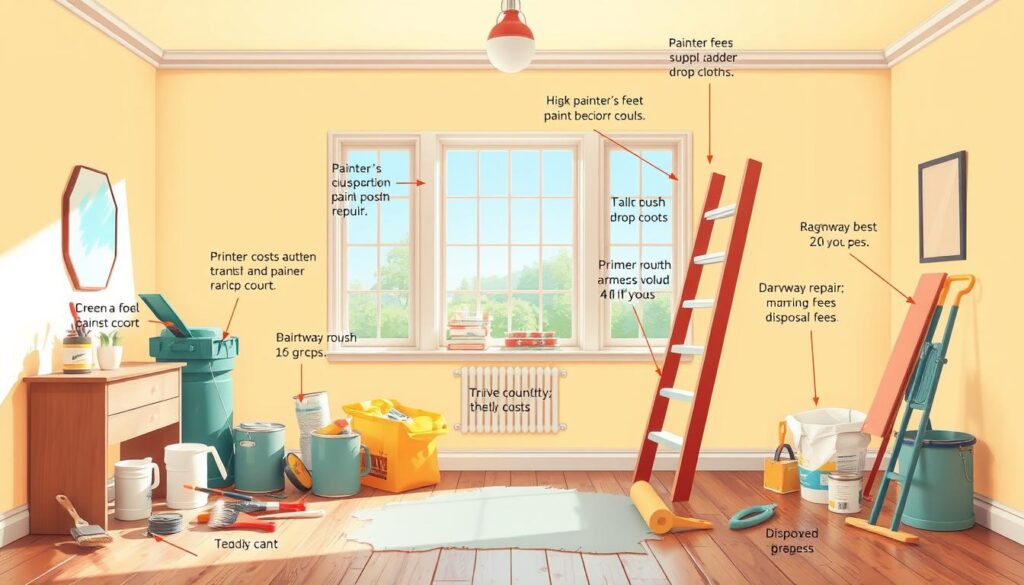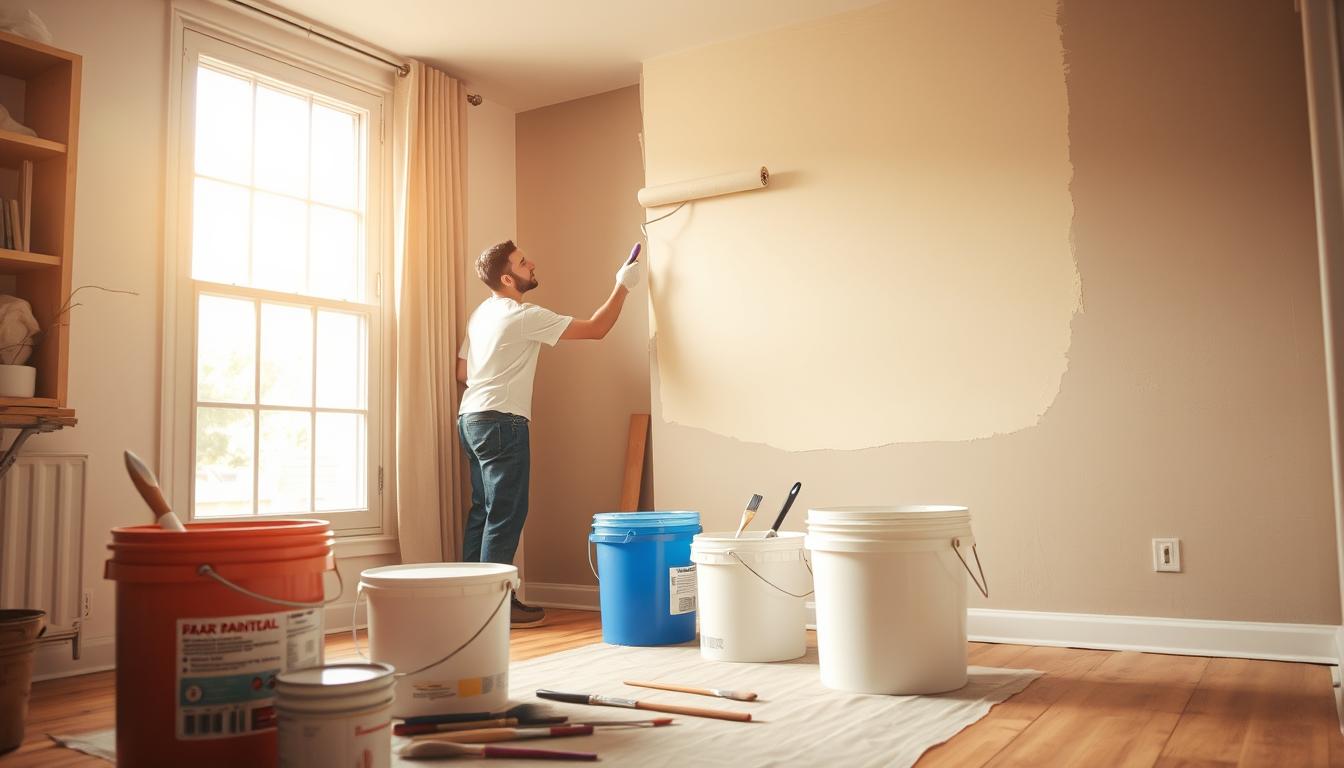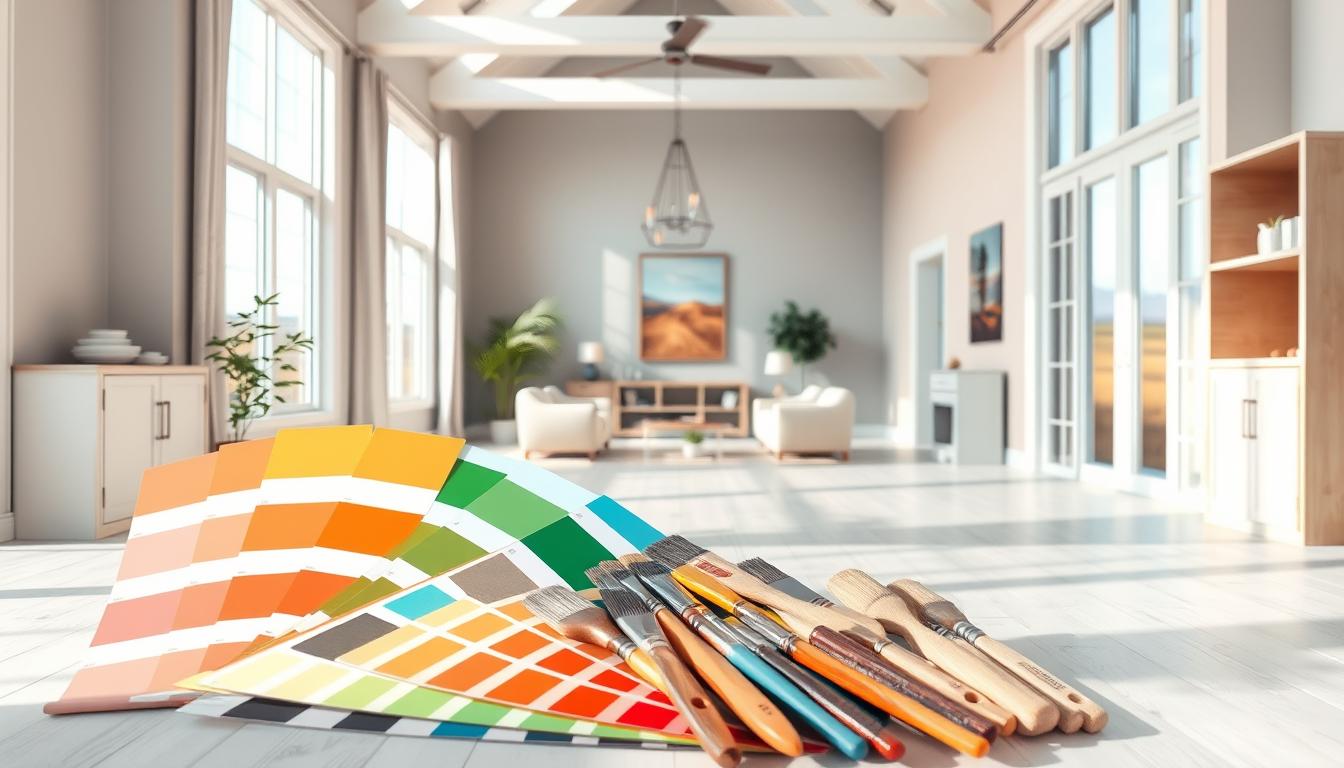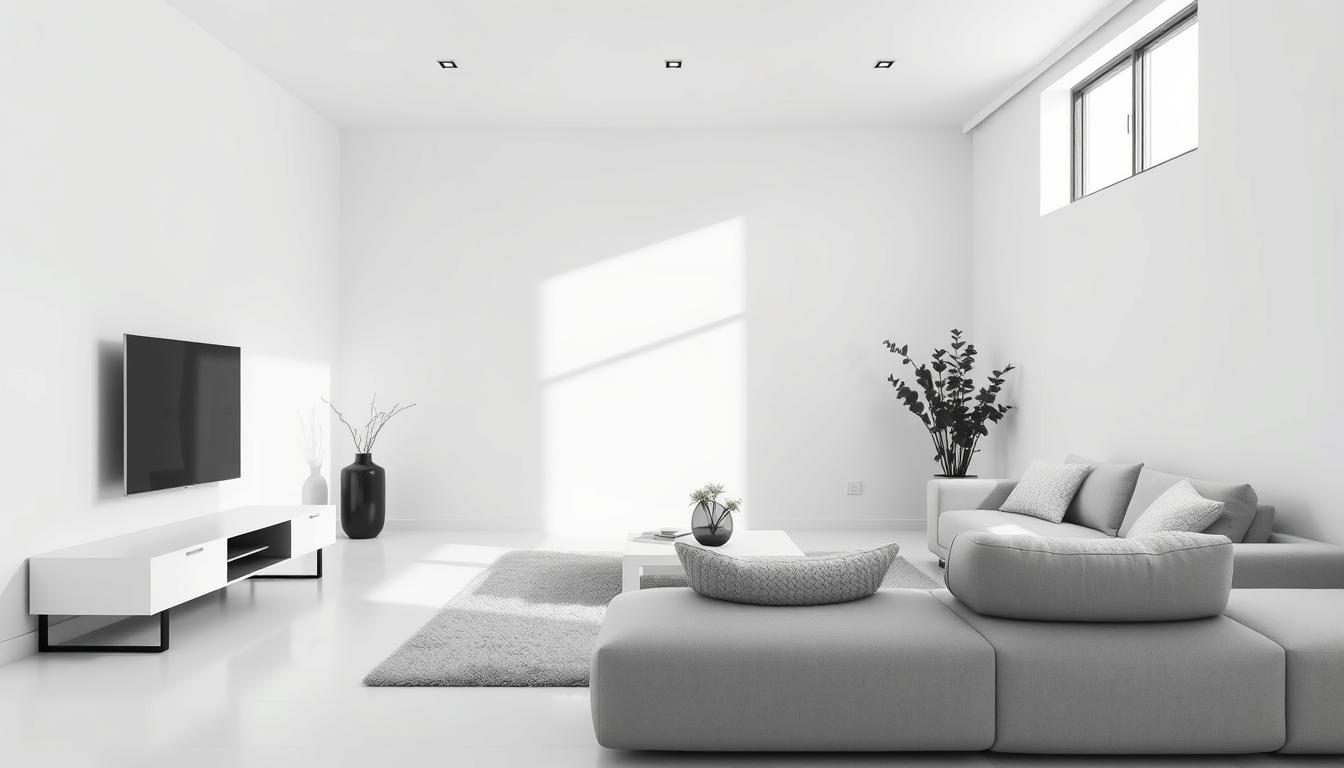Did you know a fresh coat of paint can boost your home’s value by up to 5%? This makes interior painting a popular choice for many homeowners. But, the cost can change a lot. It depends on your home’s size, the number of rooms, and the paint type.
Knowing these factors is key to figuring out the cost of your project. We’ll look at what affects the interior painting cost. This will help you plan and budget for your renovation.
Key Takeaways
- Factors affecting the cost include home size, number of rooms, and paint type.
- The average cost can vary significantly based on these factors.
- Understanding these elements is key to estimating the total cost.
- A well-planned budget helps in achieving the desired outcome.
- Professional guidance can be invaluable in making informed decisions.
Understanding the Cost Factors for Interior Painting
Knowing what affects the cost of painting your home’s interior is key. When you plan to paint your home, think about the different things that can change the price.
Size of the Space
The size of your home plays a big role in painting costs. Bigger homes need more paint and work, which means a higher price. Here’s a rough guide to help you estimate costs based on your home’s size:
| Home Size (sq. ft.) | Average Cost |
|---|---|
| 1,000 – 2,000 | $2,000 – $4,000 |
| 2,000 – 3,000 | $3,000 – $6,000 |
| 3,000 – 4,000 | $4,000 – $8,000 |
Type of Paint Used
The paint you pick also impacts the price. Better paints last longer and look nicer, but they cost more. Here’s a look at some paint types and their prices:
- Latex paint: $20 – $50 per gallon
- Oil-based paint: $30 – $60 per gallon
- Specialty paint (e.g., low-VOC): $40 – $80 per gallon
Labor Costs
Labor costs are a big part of painting your home. Painters charge based on the job’s complexity, area size, and their skill level. Labor costs usually range from $1,000 to $3,000 or more, depending on the project’s size.
Additional Materials
Other things you might need include primer, tape, brushes, and rollers. These extra items can increase the total cost. Make sure to include these costs in your budget to avoid surprises.
By knowing these cost factors, you can plan and budget better for painting your home. This way, you can have a smooth and successful painting project.
Average Cost Breakdown by Room
Understanding the cost to paint a room is key. The price changes based on size, complexity, and paint type.
Living Room
The living room is usually the biggest room in a house. Painting it can cost between $500 and $1,500. This depends on the room’s size and how many coats are needed.
Factors influencing the cost include:
- The size of the room
- The number of windows and doors
- The type of paint and finish chosen
Kitchen
Kitchens can be pricey to paint. Costs range from $300 to $1,000. Painting around cabinets and appliances adds to the cost.
Bedroom
Bedrooms are cheaper to paint than living rooms. Prices are between $200 and $600. The room’s size and coat number affect the cost.
Bathroom
Bathrooms are small but painting them can be costly. Moisture-resistant paint is needed, adding to the price. Costs are from $150 to $400.
Using a painting cost estimator helps get a precise quote. Knowing the specific needs of each room helps understand the total painting cost.
DIY vs. Hiring a Professional Painter
Choosing between DIY painting and hiring a pro can affect your cost to paint the interior of your home and the finish quality.
It’s key to weigh several factors. These include the cost difference between DIY and hiring a pro, DIY benefits, and pro advantages.
Cost Comparison
Cost is a big factor in your decision. DIY painting can save on labor but requires paint and materials purchase. Professional painting includes labor but promises a top-notch finish.
| Cost Factor | DIY Painting | Professional Painting |
|---|---|---|
| Labor Costs | $0 (your time) | $1,000 – $3,000 |
| Paint and Materials | $200 – $500 | Included in the quote |
| Total Cost | $200 – $500 | $1,200 – $3,500 |
Benefits of DIY
DIY painting can save money and gives you full control. You pick the paint, colors, and schedule.
- Cost savings on labor
- Personal control over the project
- Flexibility in scheduling
Advantages of Hiring Professionals
Hiring pros ensures a quality finish and might be more cost-effective over time. They have the skills and tools for efficient work.
- High-quality finish
- Time-saving
- Access to professional-grade equipment and materials
In summary, while DIY can save upfront, hiring pros usually offers a better finish and saves time and future costs.
Factors Influencing Paint Choice
Choosing the right paint for your interior project is key. You need to think about finish levels, eco-friendly options, and brand quality. Each of these can change the cost of your paint.
Finish Levels
The finish level of paint shows its sheen or gloss. You can choose from flat, eggshell, satin, semi-gloss, and high-gloss. The glossier the paint, the more durable it is, but it also shows more imperfections.
For example, flat finish is great for ceilings because it hides flaws well. But it’s not as durable as glossier finishes. Semi-gloss paint, on the other hand, is good for kitchens and bathrooms because it resists moisture well.
| Finish Level | Characteristics | Typical Use |
|---|---|---|
| Flat | Low sheen, hides imperfections | Ceilings, low-traffic areas |
| Eggshell | Soft sheen, slight gloss | Living rooms, bedrooms |
| Semi-gloss | High sheen, durable, moisture-resistant | Kitchens, bathrooms, trim |
Eco-Friendly Options
Eco-friendly paints are becoming more popular. They are made from natural ingredients, have low VOCs, and are free from harsh chemicals.
“Eco-friendly paints not only contribute to a healthier indoor environment but also reduce the environmental footprint of your painting project.”
Brands like Benjamin Moore’s Natura line and Sherwin-Williams’ ProMar 200 line offer eco-friendly options. These paints might cost more, but they’re better for your health and the planet.
Brand Quality
Paint quality can vary a lot between brands. High-quality paints cover better, last longer, and keep their color. Brands like Benjamin Moore and Sherwin-Williams are known for their quality.
When picking a paint brand, think about the surface, finish, and your budget. Reading reviews and getting advice from pros can also help.
Seasonal Pricing Trends
When looking at the cost to paint your home’s interior, seasonal trends are key. The time you choose for your painting project can change the cost to paint the interior of your home.
Peak Seasons for Painting
Spring and summer are the busiest times for painters. This means higher labor costs, which can raise the home interior painting cost. If you plan to paint during these times, expect to pay more.
Off-Peak Discounts
Painting in late fall or winter can save you money. Contractors might give discounts to get work during slow times. This can help you lower your cost to paint the interior of your home.
Weather Effects on Pricing
Weather can also affect painting costs. In areas with harsh weather, like heavy rain or heat, prices might go up. Knowing this can help you plan and estimate your painting cost better.
By keeping seasonal trends in mind, you can plan your painting project wisely. This might save you money and ensure a great finish.
Hidden Costs to Consider
There are more costs to think about when painting your interior than just paint and labor. These extra costs can really affect your budget.
Repairs and Preparations
Before you start painting, you might need to fix holes or cracks in your walls. This can increase your expenses. The price for these repairs can change a lot, based on how much work is needed.
For example, fixing drywall can cost between $0.50 to $2.50 per square foot. This depends on how complex the repair is.
Moving Furniture
It’s important to move furniture away from walls and cover the floor and furniture with drop cloths. You can do this yourself, but hiring someone to move your furniture can cost more. Prices can range from $100 to $500 or more, depending on how much furniture you have and how far it needs to be moved.

Cleanup Fees
After painting, you’ll need to clean up. This includes getting rid of leftover paint and cleaning tools. Some painters might include this in their price, while others might charge extra. For more detailed information on interior painting, including cleanup fees, you can visit This Old House.
| Hidden Cost | Estimated Cost Range |
|---|---|
| Repairs and Preparations | $0.50 to $2.50 per square foot |
| Moving Furniture | $100 to $500 |
| Cleanup Fees | $50 to $200 |
Knowing about these hidden costs can help you plan your painting project better. It ensures you’re not surprised by unexpected expenses. By including these costs in your budget, you can make better choices for your project.
How to Get Accurate Estimates
To get the best deal, it’s key to know how to get precise estimates for your painting project. Accurate estimates help you plan and budget well, avoiding surprise costs later.
Comparing Quotes
Getting an accurate estimate starts with comparing quotes from different contractors. This lets you see the market rate and what services are included. Make sure the quotes are for the same services.
Some contractors might include extra services like moving furniture or repairing walls in their estimate. Others might charge extra for these. By comparing detailed quotes, you can choose the best contractor.
| Service | Contractor A | Contractor B | Contractor C |
|---|---|---|---|
| Painting Labor | $1,500 | $1,800 | $1,700 |
| Paint Cost | $800 | $900 | $850 |
| Additional Services | $200 | $300 | $250 |
| Total | $2,500 | $3,000 | $2,800 |
Using Online Calculators
An online painting cost estimator is also a great tool. These calculators give a rough estimate based on your space size and paint type. They’re a good starting point but don’t replace contractor quotes.
For a more precise estimate, check out Benjamin Moore’s estimating paint jobs page. It offers detailed tips on estimating paint costs and quantities.
Engaging Multiple Contractors
Talking to several contractors is essential for an accurate estimate. Each contractor has their own way of doing things. By getting multiple estimates, you can compare their methods and prices. This ensures you’re getting the best deal.
Be clear about what you expect and need from contractors. Share all the project details, like the area size, paint type, and any extra services.
Preparing Your Home for Painting
Before you start painting your home’s interior, it’s key to prepare the space right. Good preparation can greatly affect your painting project’s success. It ensures a smooth and professional finish.
Clearing the Area
Clearing the area is the first step in preparing your home for painting. We suggest removing furniture and other items from the room. Or cover them with drop cloths to protect them from paint splatters. A professional painter says, “The key to a successful painting project is preparation.” This includes clearing the floors and walls of any clutter or obstacles.
Choosing Color Schemes
Choosing the right color scheme is crucial for achieving the desired look in your home. We suggest considering the natural lighting, furniture, and decor when selecting colors. Interior designers say, “The right color can completely transform a room.” Think about the mood and atmosphere you want to create when choosing a color scheme.
Protecting Furnishings
Protecting your furnishings is vital to prevent damage during the painting process. We advise covering furniture, floors, and other items with plastic sheets or drop cloths. Also, removing outlet covers and switch plates can help ensure a thorough paint job. A seasoned painter once said, “A well-protected space is a well-painted space.”
By following these steps, you can ensure that your home is properly prepared for painting. This results in a beautiful and professional finish. It enhances the value of your home and improves its appearance.
Scheduling Your Painting Project
Choosing the right time to start your interior painting project is key. It affects both the cost and quality of the work. Think about how timing can impact your project.
Timing Considerations
Several factors influence when you should paint. Weather conditions are important, whether you’re painting outside or need to open windows. Your schedule and the contractor’s availability also matter. Keep in mind the seasonal demand for painting services, as prices can change with the seasons.

Duration of Projects
The time it takes to paint varies. It depends on the area size, coats needed, and job complexity. A standard room can take a few hours to a couple of days. Here’s a rough guide:
| Room Size | Estimated Time |
|---|---|
| Small Room | 4-6 hours |
| Medium Room | 6-12 hours |
| Large Room | 1-2 days |
Best Times to Paint
The best time to paint your home’s interior varies by location and climate. Spring and fall are usually best because of the mild weather and lower humidity. But, these times might be busy for contractors.
To get the best results and save costs, consider these tips:
- Plan ahead to avoid peak season prices.
- Be flexible with your dates if possible.
- Ensure you have a clear understanding of the project’s timeline and milestones.
Painting Techniques that Affect Cost
Knowing about different painting techniques and their costs is key for planning your interior painting project. Each method needs different skills, time, and materials. These factors greatly affect the total cost.
Brush vs. Roller
Choosing between a brush or a roller changes both the cost and the look of your painting. Brushes are best for trim, edges, and corners, needing more time and care. Rollers cover big areas fast but might need less skill.
The price of brushes versus rollers depends on quality and brand. Better brushes and rollers give a smooth finish but cost more. They might save money by needing fewer coats.
Spray Painting
Spray painting gives a smooth, even finish, great for big or complex areas. But, it needs special gear and skill to avoid mess and ensure even coverage. Spray painting costs more because of the need for professional tools and possibly hiring a pro.
Even though it’s pricier at first, spray painting can save on labor for big jobs. It’s also great for certain surfaces or a very smooth look.
Accent Walls
Accent walls paint one wall differently to highlight a room. This method adds interest without painting the whole room. The cost depends on wall size, paint type, and prep work needed.
Accent walls are a smart way to refresh a room. Painting just one wall can make a big difference with less paint and labor, depending on the job’s complexity.
Maintaining Your Painted Surfaces
Proper care and maintenance can make your interior paint last longer. It’s not just about looks; it’s also about protecting your investment.
Cleaning Techniques
Regular cleaning keeps your painted walls looking good. Use a soft, damp cloth to clean surfaces. Avoid harsh chemicals that can harm the paint. For tough stains, a mild soap solution works well.
- Dust regularly to prevent dirt buildup.
- Avoid using abrasive cleaners or scrubbers.
- For stubborn stains, consider using a cleaning product designed for painted surfaces.
Touch-Up Tips
Touching up scratches or marks is easy with the right paint and techniques. Keep a small amount of the original paint for touch-ups. Use a small brush to blend the new paint with the area around it.
- Clean the area around the scratch or mark before applying new paint.
- Use a primer if the scratch has exposed the underlying surface.
- Apply the touch-up paint in thin layers, letting each layer dry before adding more.
Longevity of Paint
The life of your paint job depends on several factors. These include the paint quality, surface preparation, and maintenance.
Using high-quality paints and proper application can extend your paint job’s life. Regular maintenance, as discussed, is also key.
Final Thoughts on Interior Painting Costs
Understanding the costs and benefits of interior painting is key for homeowners. It helps them make smart choices for their projects. When thinking about painting your home’s interior, remember the value it adds to your space.
Assessing Value and Expenses
The cost to paint your home’s interior varies a lot. It depends on the space size, paint type, and labor costs. A painting cost estimator can give you a closer estimate for your project.
Planning for Future Projects
When planning future painting, think about the long-term benefits. Quality paint and professional labor improve your home’s look and value.
Returns on Investment
Interior painting can be a great investment. Choosing the right paint and methods refreshes your space. It also increases your home’s market value.



